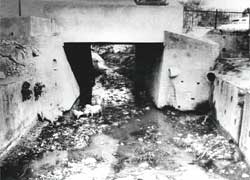Water alarm
 a yet unpublished paper on groundwater quality in Delhi, conducted by scientists of the Nuclear Research Laboratory ( nrl ), of the Indian Agricultural Research Institute, indicates that 33 per cent of the groundwater shows nitrate contents exceeding the general acceptable limits (20 parts per million; ppm) , and 15 per cent crossed the maximum permissible limit (45 ppm). The study shows that indiscriminate discharge of wastes on land and in drains has also contributed to high levels of nitrates, in certain places.
a yet unpublished paper on groundwater quality in Delhi, conducted by scientists of the Nuclear Research Laboratory ( nrl ), of the Indian Agricultural Research Institute, indicates that 33 per cent of the groundwater shows nitrate contents exceeding the general acceptable limits (20 parts per million; ppm) , and 15 per cent crossed the maximum permissible limit (45 ppm). The study shows that indiscriminate discharge of wastes on land and in drains has also contributed to high levels of nitrates, in certain places.
According to the study, Assessment of groundwater contamination from fertilizers in Delhi area , groundwater accounted for nearly 50 per cent of Delhi's domestic and industrial supplies. The study adds that the extent to which fertilizer application adds to the nitrate problem in Delhi is not known. Groundwater, moderately to highly saline in all parts of Delhi, was also found to contain high levels of potassium.
"There is a possibility that nitrate in drinking water may get converted into nitrite in the gastrointestinal tract with the subsequent formation of nitrosamines. Some nitrosamines are known to be carcinogenic, and health effects on long-term exposures are potentially serious,' states P S Datta of the nrl .
Application of nitrogen fertlizer in Delhi in the last decade has increased significantly and now stands at above 300 kg/ha ( Fertilizer Statistics 1993-94 ). The fertilizers used are urea, ammonium sulphate, calcium ammonium nitrate, diammonium phosphate and ammonium chloride. This creates a blanket non-point source of nitrate (a non-point source is one that cannot be pinpointed. For example, in the case of water pollution in a river, a point source is a drain. But run-off, all along the river banks constitute a non-point source). Flood irrigation and rains accentuate this entry.
The study states that other sources of nitrate are waste-water drains, cattle-sheds, recharge of groundwater, nature of vegetation cover, microbial reactions in soil and human activity. "Seepage of nitrates from the western Yamuna canal and other drains has been found to be another source. Nitrate levels of domestic waste-water range from 18-28 ppm. The sub-soil structure indicates that this contaminated groundwater from the source areas migrates towards the urbanised Delhi,' says D L Deb, of the nrl .
Pointing out to the fact that there are not enough plants to take up nitrates produced naturally, the scientists add that significant quantities of evaporated irrigation water infiltrate alongwith fertilizer nitrate to the groundwater system. They recommend that application of this nitrate-rich water for agriculture could minimise the requirement of inorganic fertilizers and would be helpful in protecting groundwater from further degradation. This would also bring down the cost of cultivation, through appropriate management of fertilizer application.
Of the total geographical area of Delhi (1485 sq km), half remains agricultural land. In this area, groundwater irrigation has shown an upward trend, primarily because irrigation canals have not been regular sources of water. The geohydrology of Delhi is such that drainage to the east of the Ridge enters the Yamuna, whereas to the west, drainage is to the natural depression in the southwestern part. A large part of Delhi already has alkaline and saline soils (alkaline soils contain sodium bicarbonate and carbonate among soluble salts, while saline soils are impreganated with sodium chloride and sulphate as the main soluble salts). Additional salts from fertilizers, therefore, make the situation worse.
Interestingly, another study by the nrl , Major Ion Chemistry of Groundwater in Delhi Area , finds excessive calcium suplhate in groundwaters of the Alipur and Nangloi blocks. This indicates calcite weathering by sulphuric acid. "Sulphric acid maybe produced by sulphur-dioxide ( so 2 ) emissions from power stations and automobile pollution,' the study notes.
Related Content
- Reply affidavit Ministry of Jal Shakti on the impact of climate change on Himalayan glaciers, 07/03/2025
- Order of the Punjab and Haryana High Court regarding unauthorized constructions in areas of DLF City, Gurugram, Haryana, 13/02/2025
- Order of the Delhi High Court regarding STP and CETPs to curb untreated water flowing into river Yamuna, Delhi, 28/01/2025
- Order of the National Green Tribunal regarding state of groundwater in Haryana, 23/01/2025
- Blue and Green Drop Project Report 2024
- Order of the National Green Tribunal regarding pollution of Madambakkam lake, Tambaram, Tamil Nadu, 11/11/2024
